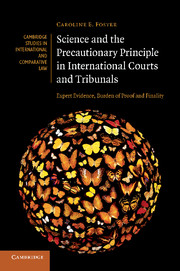 Science and the Precautionary Principle in International Courts and Tribunals
Science and the Precautionary Principle in International Courts and Tribunals Published online by Cambridge University Press: 11 April 2011
Scientific disputes pose new challenges within the rationalist conception of adjudication in the international setting. Important factual elements of such disputes are acknowledged as unknowable, and so it becomes difficult to maintain a strict traditional rationalist conception of adjudication as a process where the law is applied to the facts. As a result, scientific disputes are generating renewed attention to rules about evidence and proof in international courts and tribunals.
The scientific disputes discussed in this book are ‘live’ policy cases where complainants want respondents to change their conduct. These cases differ from other disputes where complainants are seeking only compensation or the restoration of their dignity. At the national level it has been suggested that policy disputes call for a modification to traditional adversarial procedure. This is precisely what is taking place in international courts and tribunals, as they increasingly experiment with a wide range of methods for investigating central aspects of these scientific disputes.
Among the results of this experimentation is a greater reliance on expert evidence. Here, complex problems begin to arise. Many of the legal rules that are applicable will have been crafted with scientific uncertainty in mind. They may incorporate tests according to which a state is required to conduct itself as ‘necessary’ in the circumstances, or take steps based on ‘sufficient’ scientific evidence, for example. International courts and tribunals will need the close assistance of experts to interpret and apply these tests in different contexts.
To save this book to your Kindle, first ensure [email protected] is added to your Approved Personal Document E-mail List under your Personal Document Settings on the Manage Your Content and Devices page of your Amazon account. Then enter the ‘name’ part of your Kindle email address below. Find out more about saving to your Kindle.
Note you can select to save to either the @free.kindle.com or @kindle.com variations. ‘@free.kindle.com’ emails are free but can only be saved to your device when it is connected to wi-fi. ‘@kindle.com’ emails can be delivered even when you are not connected to wi-fi, but note that service fees apply.
Find out more about the Kindle Personal Document Service.
To save content items to your account, please confirm that you agree to abide by our usage policies. If this is the first time you use this feature, you will be asked to authorise Cambridge Core to connect with your account. Find out more about saving content to Dropbox.
To save content items to your account, please confirm that you agree to abide by our usage policies. If this is the first time you use this feature, you will be asked to authorise Cambridge Core to connect with your account. Find out more about saving content to Google Drive.